Pakizar Shamoi
Color Models in Image Processing: A Review and Experimental Comparison
Oct 01, 2025Abstract:Color representation is essential in computer vision and human-computer interaction. There are multiple color models available. The choice of a suitable color model is critical for various applications. This paper presents a review of color models and spaces, analyzing their theoretical foundations, computational properties, and practical applications. We explore traditional models such as RGB, CMYK, and YUV, perceptually uniform spaces like CIELAB and CIELUV, and fuzzy-based approaches as well. Additionally, we conduct a series of experiments to evaluate color models from various perspectives, like device dependency, chromatic consistency, and computational complexity. Our experimental results reveal gaps in existing color models and show that the HS* family is the most aligned with human perception. The review also identifies key strengths and limitations of different models and outlines open challenges and future directions This study provides a reference for researchers in image processing, perceptual computing, digital media, and any other color-related field.
COLIBRI Fuzzy Model: Color Linguistic-Based Representation and Interpretation
Jul 15, 2025Abstract:Colors are omnipresent in today's world and play a vital role in how humans perceive and interact with their surroundings. However, it is challenging for computers to imitate human color perception. This paper introduces the Human Perception-Based Fuzzy Color Model, COLIBRI (Color Linguistic-Based Representation and Interpretation), designed to bridge the gap between computational color representations and human visual perception. The proposed model uses fuzzy sets and logic to create a framework for color categorization. Using a three-phase experimental approach, the study first identifies distinguishable color stimuli for hue, saturation, and intensity through preliminary experiments, followed by a large-scale human categorization survey involving more than 1000 human subjects. The resulting data are used to extract fuzzy partitions and generate membership functions that reflect real-world perceptual uncertainty. The model incorporates a mechanism for adaptation that allows refinement based on feedback and contextual changes. Comparative evaluations demonstrate the model's alignment with human perception compared to traditional color models, such as RGB, HSV, and LAB. To the best of our knowledge, no previous research has documented the construction of a model for color attribute specification based on a sample of this size or a comparable sample of the human population (n = 2496). Our findings are significant for fields such as design, artificial intelligence, marketing, and human-computer interaction, where perceptually relevant color representation is critical.
Sentiment and Emotion-aware Multi-criteria Fuzzy Group Decision Making System
Aug 21, 2024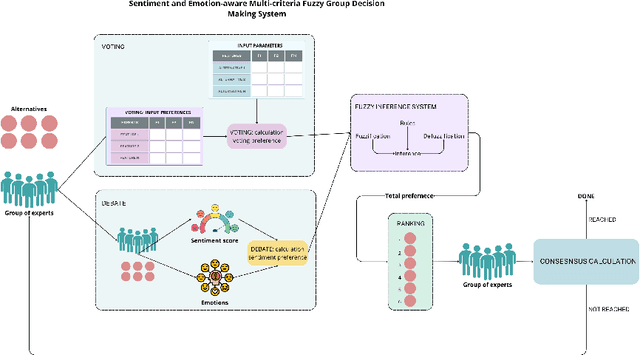

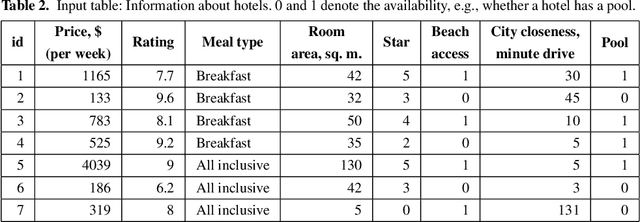
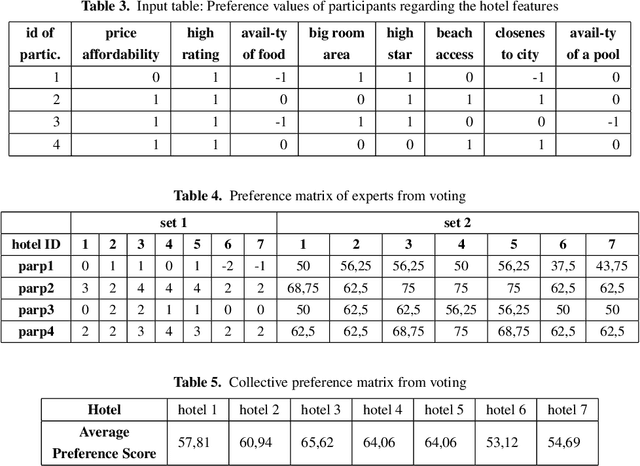
Abstract:In today's world, making decisions as a group is common, whether choosing a restaurant or deciding on a holiday destination. Group decision-making (GDM) systems play a crucial role by facilitating consensus among participants with diverse preferences. Discussions are one of the main tools people use to make decisions. When people discuss alternatives, they use natural language to express their opinions. Traditional GDM systems generally require participants to provide explicit opinion values to the system. However, in real-life scenarios, participants often express their opinions through some text (e.g., in comments, social media, messengers, etc.). This paper introduces a sentiment and emotion-aware multi-criteria fuzzy GDM system designed to enhance consensus-reaching effectiveness in group settings. This system incorporates natural language processing to analyze sentiments and emotions expressed in textual data, enabling an understanding of participant opinions besides the explicit numerical preference inputs. Once all the experts have provided their preferences for the alternatives, the individual preferences are aggregated into a single collective preference matrix. This matrix represents the collective expert opinion regarding the other options. Then, sentiments, emotions, and preference scores are inputted into a fuzzy inference system to get the overall score. The proposed system was used for a small decision-making process - choosing the hotel for a vacation by a group of friends. Our findings demonstrate that integrating sentiment and emotion analysis into GDM systems allows everyone's feelings and opinions to be considered during discussions and significantly improves consensus among participants.
Tracking Emotional Dynamics in Chat Conversations: A Hybrid Approach using DistilBERT and Emoji Sentiment Analysis
Aug 03, 2024Abstract:Computer-mediated communication has become more important than face-to-face communication in many contexts. Tracking emotional dynamics in chat conversations can enhance communication, improve services, and support well-being in various contexts. This paper explores a hybrid approach to tracking emotional dynamics in chat conversations by combining DistilBERT-based text emotion detection and emoji sentiment analysis. A Twitter dataset was analyzed using various machine learning algorithms, including SVM, Random Forest, and AdaBoost. We contrasted their performance with DistilBERT. Results reveal DistilBERT's superior performance in emotion recognition. Our approach accounts for emotive expressions conveyed through emojis to better understand participants' emotions during chats. We demonstrate how this approach can effectively capture and analyze emotional shifts in real-time conversations. Our findings show that integrating text and emoji analysis is an effective way of tracking chat emotion, with possible applications in customer service, work chats, and social media interactions.
Image Classification using Fuzzy Pooling in Convolutional Kolmogorov-Arnold Networks
Jul 23, 2024



Abstract:Nowadays, deep learning models are increasingly required to be both interpretable and highly accurate. We present an approach that integrates Kolmogorov-Arnold Network (KAN) classification heads and Fuzzy Pooling into convolutional neural networks (CNNs). By utilizing the interpretability of KAN and the uncertainty handling capabilities of fuzzy logic, the integration shows potential for improved performance in image classification tasks. Our comparative analysis demonstrates that the modified CNN architecture with KAN and Fuzzy Pooling achieves comparable or higher accuracy than traditional models. The findings highlight the effectiveness of combining fuzzy logic and KAN to develop more interpretable and efficient deep learning models. Future work will aim to expand this approach across larger datasets.
Comparative Analysis Of Color Models For Human Perception And Visual Color Difference
Jun 27, 2024Abstract:Color is integral to human experience, influencing emotions, decisions, and perceptions. This paper presents a comparative analysis of various color models' alignment with human visual perception. The study evaluates color models such as RGB, HSV, HSL, XYZ, CIELAB, and CIELUV to assess their effectiveness in accurately representing how humans perceive color. We evaluate each model based on its ability to accurately reflect visual color differences and dominant palette extraction compatible with the human eye. In image processing, accurate assessment of color difference is essential for applications ranging from digital design to quality control. Current color difference metrics do not always match how people see colors, causing issues in accurately judging subtle differences. Understanding how different color models align with human visual perception is crucial for various applications in image processing, digital media, and design.
Liveness Detection in Computer Vision: Transformer-based Self-Supervised Learning for Face Anti-Spoofing
Jun 19, 2024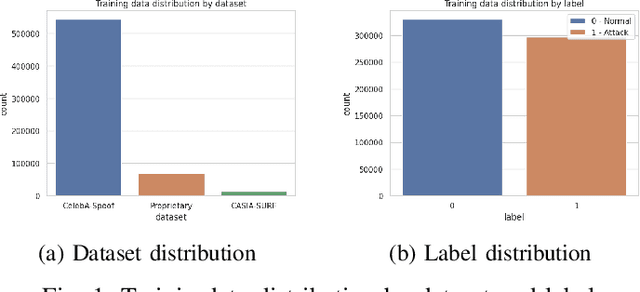
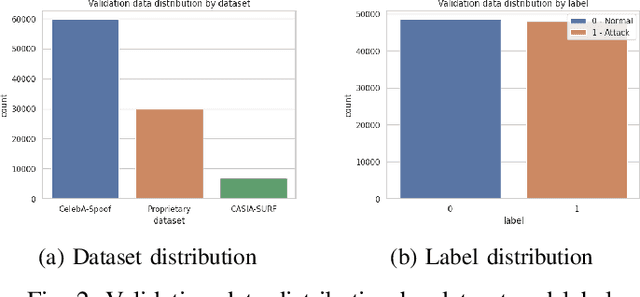
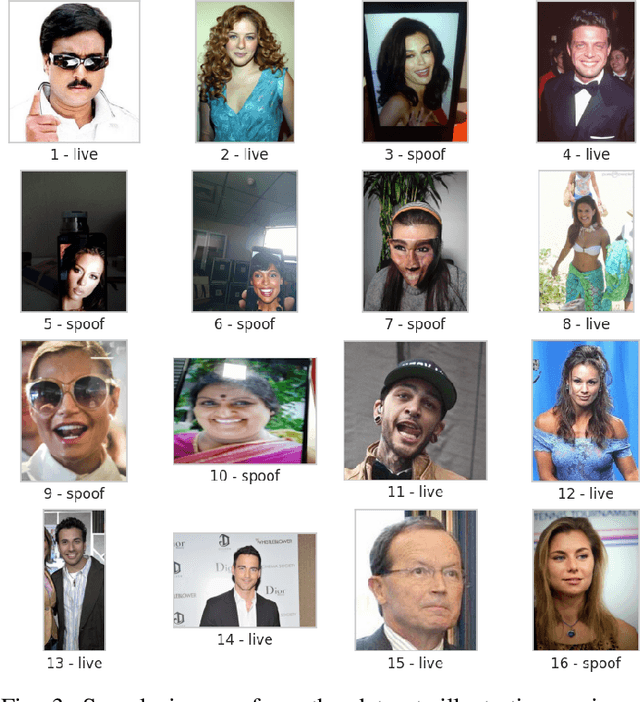
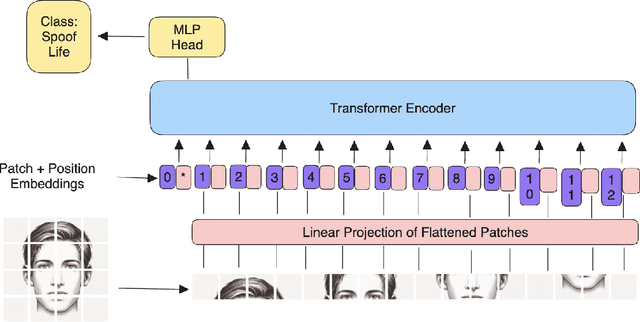
Abstract:Face recognition systems are increasingly used in biometric security for convenience and effectiveness. However, they remain vulnerable to spoofing attacks, where attackers use photos, videos, or masks to impersonate legitimate users. This research addresses these vulnerabilities by exploring the Vision Transformer (ViT) architecture, fine-tuned with the DINO framework. The DINO framework facilitates self-supervised learning, enabling the model to learn distinguishing features from unlabeled data. We compared the performance of the proposed fine-tuned ViT model using the DINO framework against a traditional CNN model, EfficientNet b2, on the face anti-spoofing task. Numerous tests on standard datasets show that the ViT model performs better than the CNN model in terms of accuracy and resistance to different spoofing methods. Additionally, we collected our own dataset from a biometric application to validate our findings further. This study highlights the superior performance of transformer-based architecture in identifying complex spoofing cues, leading to significant advancements in biometric security.
Fuzzy Intelligent System for Student Software Project Evaluation
May 01, 2024



Abstract:Developing software projects allows students to put knowledge into practice and gain teamwork skills. However, assessing student performance in project-oriented courses poses significant challenges, particularly as the size of classes increases. The current paper introduces a fuzzy intelligent system designed to evaluate academic software projects using object-oriented programming and design course as an example. To establish evaluation criteria, we first conducted a survey of student project teams (n=31) and faculty (n=3) to identify key parameters and their applicable ranges. The selected criteria - clean code, use of inheritance, and functionality - were selected as essential for assessing the quality of academic software projects. These criteria were then represented as fuzzy variables with corresponding fuzzy sets. Collaborating with three experts, including one professor and two course instructors, we defined a set of fuzzy rules for a fuzzy inference system. This system processes the input criteria to produce a quantifiable measure of project success. The system demonstrated promising results in automating the evaluation of projects. Our approach standardizes project evaluations and helps to reduce the subjective bias in manual grading.
Fuzzy Inference System for Test Case Prioritization in Software Testing
Apr 25, 2024



Abstract:In the realm of software development, testing is crucial for ensuring software quality and adherence to requirements. However, it can be time-consuming and resource-intensive, especially when dealing with large and complex software systems. Test case prioritization (TCP) is a vital strategy to enhance testing efficiency by identifying the most critical test cases for early execution. This paper introduces a novel fuzzy logic-based approach to automate TCP, using fuzzy linguistic variables and expert-derived fuzzy rules to establish a link between test case characteristics and their prioritization. Our methodology utilizes two fuzzy variables - failure rate and execution time - alongside two crisp parameters: Prerequisite Test Case and Recently Updated Flag. Our findings demonstrate the proposed system capacity to rank test cases effectively through experimental validation on a real-world software system. The results affirm the practical applicability of our approach in optimizing the TCP and reducing the resource intensity of software testing.
Multi-channel Emotion Analysis for Consensus Reaching in Group Movie Recommendation Systems
Apr 21, 2024Abstract:Watching movies is one of the social activities typically done in groups. Emotion is the most vital factor that affects movie viewers' preferences. So, the emotional aspect of the movie needs to be determined and analyzed for further recommendations. It can be challenging to choose a movie that appeals to the emotions of a diverse group. Reaching an agreement for a group can be difficult due to the various genres and choices. This paper proposes a novel approach to group movie suggestions by examining emotions from three different channels: movie descriptions (text), soundtracks (audio), and posters (image). We employ the Jaccard similarity index to match each participant's emotional preferences to prospective movie choices, followed by a fuzzy inference technique to determine group consensus. We use a weighted integration process for the fusion of emotion scores from diverse data types. Then, group movie recommendation is based on prevailing emotions and viewers' best-loved movies. After determining the recommendations, the group's consensus level is calculated using a fuzzy inference system, taking participants' feedback as input. Participants (n=130) in the survey were provided with different emotion categories and asked to select the emotions best suited for particular movies (n=12). Comparison results between predicted and actual scores demonstrate the efficiency of using emotion detection for this problem (Jaccard similarity index = 0.76). We explored the relationship between induced emotions and movie popularity as an additional experiment, analyzing emotion distribution in 100 popular movies from the TMDB database. Such systems can potentially improve the accuracy of movie recommendation systems and achieve a high level of consensus among participants with diverse preferences.
 Add to Chrome
Add to Chrome Add to Firefox
Add to Firefox Add to Edge
Add to Edge